In the first half of the twentieth century, government economic policies were designed to meet local consumer demand and to reduce the nation's reliance on its mining sector by providing incentives for farming and for establishing manufacturing enterprises. But the government also saw its role as helping to defend white farmers and businessmen from African competition. In 1913 the Natives Land Act reserved most of the land for white ownership, forcing many black farmers to work as wage labourers on land they had previously owned. When the act was amended in 1936, black land ownership was restricted to 13 percent of the country, much of it heavily destroyed over time. White farmers received other privileges, such as loans from a government Land Bank (created in 1912), labour law protection, and crop subsidies. Marketing boards, which were established to stabilize production of many crops, paid more for produce from white farmers than for produce from black farmers. All farm activity suffered from the cyclical droughts that swept the subcontinent, but white farmers received greater government protection against economic losses.
Control over black workers, closed compounds and migrant labour
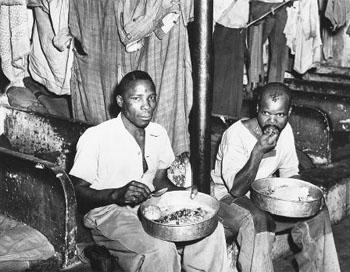 Miners eating in their compound Image source
Miners eating in their compound Image source
With the discovery of diamonds in South Africa, institutionalised forms of labour control such as the compound/ hostel system now emerged, and in the industrial environment exploitative relations now assumed the same racial form as that which already existed in the rural areas. Migrant labour ensured a supply of cheap wage labour to the mining sector and secondary industry. What is unique about South African migrant labour is the disallowance on internal migrants from settling at their work places. Bonds of kinship determined production and reproduction within economic systems based on subsistence agriculture and the herding of cattle. Chiefs and lineage heads governed access to land, controlled the allocation of labour and ensured the payment of various forms of tribute. Crucially, marriage was controlled by the elders who owned the herds of cattle necessary for bride wealth.
So, when Africans went to work in the diamond mines they were not 'free' wage labourers, in the sense of labourers 'free' from the land and labourers 'free' to sell their capacity to work. In any case, their social responsibilities denied them the freedom to dispose of their labour as individuals. The mines found prison labour cheap and tractable, and soon – in the name of antitheft security – hit on the idea of housing their workers in entirely self-sufficient closed compounds. Workers shopped at the company store and were treated at the company clinic. Escorted by guards armed with clubs, the workers marched from the compound straight to work along walkways covered to prevent any communication with outsiders.
Different ethnic groups were deliberately kept apart from each other to make it difficult for ‘natives’ to form groups with others to riot against their living conditions. Black workers deemed ‘troublesome or turbulent’ were expelled, but only after first taking photographs which were pasted into a blacklist kept at the compound entrance. When these measures fell short, the compound managers could always call on government, as they did at Wesselton mine in March 1894 when three miners were shot dead by the Kimberley Mounted Police and compound guards.
Land Dispossession and Defeat of African Kingdoms (Xhosa, 1878 & Pedi and Zulu, 1879)
An alliance between Khoikhoi rebels in the colony and the Xhosa chiefs between 1799 and 1802 saw the displacement of colonials from the frontier farms, which neither the British not the Dutch were able to reverse. The droughts between 1800 and 1830 brought distress to the Cape Colony (food had to be imported) and exacerbated conflict between the colonials and the Xhosa over cattle and grazing land. Initially, the aim of British policy was to maintain a strict policy of segregation with the Xhosas excluded from the territory of the Colony and in 1811-1812 Governor Cradock was successful in savagely ejecting the Ndlambe and other Xhosa beyond the Fish River into the territory of the Ngqika chiefdom. Governor Somerset attempted to hold the Ngqika accountable for the conduct of all the Xhosa chiefdoms, over whom they exerted only nominal commonwealth, but the Ndlambe routed the Ngqika, forcing the British to intervene to rescue their client in 1819. Somerset annexed the area between the Fish and Keiskamma rivers to create a no man's land, buffer zone, deporting Ngqika ally and Ndlambe adversaryalike, throwing both into further economic affliction and forming the foundation for future conflict.
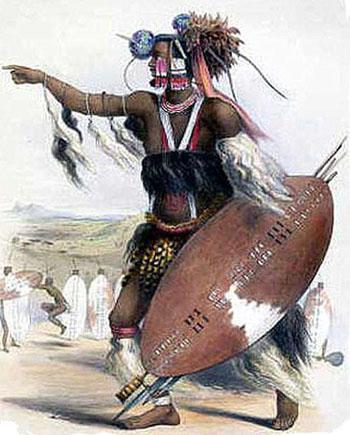 King Shaka Zulu. Image source
King Shaka Zulu. Image source
The Portuguese in Delgoa Bay, from 1815 onwards, began exporting large numbers of slaves obtained in the interior, leading to massive population displacements as people fled the slave raiders. The droughts further destabilized the society of the already densely populated Nguni of KwaZulu-Natal as migration and marauding stimulated the emergence and decline of successive powerful chiefdoms like the Zulu.With the military innovations of Shaka, the Zulu were able to consolidate themselves into a powerful highly centralized kingdom between 1816 and 1824. The brutal rise of the Zulu kingdom unleashed great suffering; Shaka used a scorched earth policy resulting in massive population movements of starving fugitives and an estimated half to one million people perished in the process. By the 1870s, discerned black rulers could foresee the time that they would have to fight for their independence and they began to arm their people accordingly. Foremost among these was King Sekhukhune of the Pedi who sent whole regiments (travelling 200 men at a time on account of the dangers of the journey) to work in Kimberley. The Pedi chiefdom, under Sekhukhune, defeated the Boers in 1876 and expelled them from the northern areas claimed by the ZAR, leading to the British annexation of the ZAR in 1877 and the subjugation of the Pedi by British forces in 1879. The British then provoked a war with the Zulu Kingdom in 1879, defeated them, and annexed Zululand to the Natal Colony.
Deep Level Gold Mining on the Witwatersrand from 1886 onwards
Why is Gold Valuable?
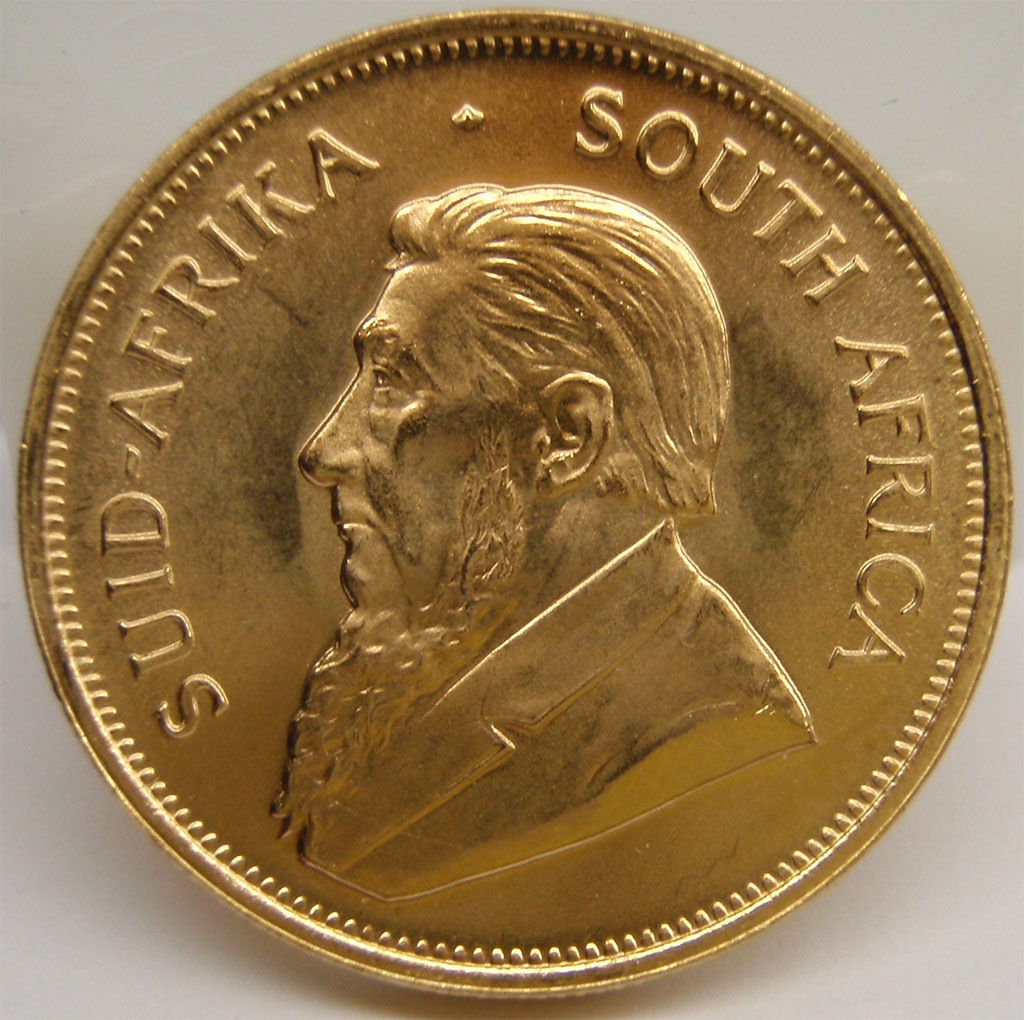 A South African Krugerrand Gold Coin Image source
A South African Krugerrand Gold Coin Image source
For thousands of years it has been used as a bauble of kings, a standard for global currencies, in competitions as symbol of victory and more recently, in a wide range of electronic devices and medical applications. Ancient civilizations used gold for the decoration of tombs and temples. Gold is a dense, soft, shiny, malleable, and ductile metal. It is a chemical element with the symbol Au and atomic number 79 with a symbol of Au. Gold is the most malleable and ductile of all the metals, and it is important to consider that gold is rather scarce.It's quite hard to find and extract in large quantities with pre-industrial technology. Its principal characteristics of being highly corrosion-resistant and easily worked made it highly desirable (and still do) for decorative purposes, and even more so industrially, e.g. where you need high quality electrical connectors.
Discovery and mining of deep level gold on Witwatersrand
How is Gold mined in South Africa?
Gold mining in South Africa typically involves methods such as panning, sluicing, dredging, hard rock mining, and by-product mining. For most effective gold mining in South Africa, the method used is hard rock mining, since reserves are typically fully encased in rock deep underground. The invention of industrial air cooling and air quality control systems saw gold mines reach unprecedented depths – the deepest being 3 900 metres. This method is accompanied by chemical beneficiation, where chemicals, such as cyanide, or activated carbon are added to rough ore and processed – sometimes with heat, water, agitation, electro-winning etc. Modern gold beneficiation methods can produce gold of 99.9999% purity. Making the refining process more thorough and economically viable, gold mining in South Africa projects, such as the ERGO Mines Joint Venture in Brakpan, will facilitate the re-processing of 1.7 billion tonnes of gold tailings to refine a further 15 million ounces of gold.Over 50% of all gold reserves are found in South Africa, where the Witwatersrand holds the world’s largest gold reef deposit. In 2007, gold mining in South Africa employed over 240 000 people and accounted for R49 billion in foreign currency earnings.
Conditions Underground
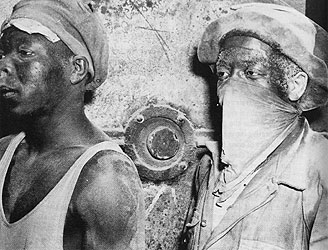 A mineworker trying to protect himself from the dust in the mines Image source
A mineworker trying to protect himself from the dust in the mines Image source
One of the legacies of Randlords to mining in the country is the poor working conditions of many Black South Africans. Slowly this has improved but it remains a problem. Compared to other countries, South African mines are composed of ore bodies which are formed from ore minerals and waste rocks. It has its benefits in that it allows mining companies to dig deeper than anywhere else in the world. On the other hand, the mining area becomes unbearably hot and narrow. Another problem with mining in the country is the silica dust which can cause silicosis, a lethal lung disease. Machines cannot be used in the depths of the mining caves which mean human labour is the only option for now.
Randlords and the formation of the Chamber of Mines
Within a few years of the discovery of gold in 1886 the gold mines of the Witwatersrand brought riches undreamed of to the government and to the Randlords, a relatively small group of financiers and magnates at the apex of the mining industry. They discovered the value of setting up a ‘group system’ – five or six main ‘groups’ or ‘finance houses’ that exercised control of several mining companies by way of the shares they held. There was no competition between corporations for markets, and companies could sell all the gold they produced. The profits they made were to a decisive extent determined by their ability to cut costs, particularly labour costs. They realised that South Africa must change in important ways if their mines were to be as profitable as they wanted them to be.Thus they formed the Chamber of Mines in 1887 to eliminate competition among them for labour. They also shared technological advances that brought down labour costs. The Chamber of Mines became a powerful organisation serving the mining companies and getting them to agree to common policies on wages, finding workers and how to deal with the government.
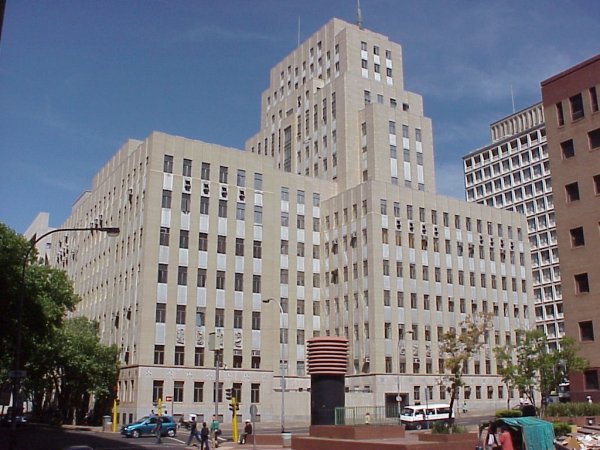 Chamber Of Mines Building, Johannesburg Image source
Chamber Of Mines Building, Johannesburg Image source
The Chamber's primary functions are described as being to promote and protect the interests of its members, doing this through joint action, at industrial level in areas where it is considered by the Chamber to be economically beneficial, prudent and desirable for members to co-operate and act in concert. It operates through a range of committees on which sit representatives of the major finance houses and mining companies and at which policy agreements are arrived at.
Migrant Workers and Mining
"Migrant labour" in South Africa referred not only to workers coming into South Africa from neighbouring countries, but also to a system of controlling African workers within South Africa. Migrant labour provided abundant cheap African labour for white-owned mines and farms (and later factories) and, at the same time, enforced racial segregation of land. Male migrants employed by white-owned businesses were prohibited from living permanently in cities and towns designated for whites only. Hundreds of thousands of African men lived in crowded single-sex hostels near their jobs and were not allowed to bring their wives and children, who were described as "superfluous appendages."The mining industry was locked into the migrant labour system which gave it a control over the labour force so that there was no question of strikes, which were illegal, and there was dominance of management over labour. By 1910, workers were being recruited from all over Southern Africa but far from Johannesburg itself.
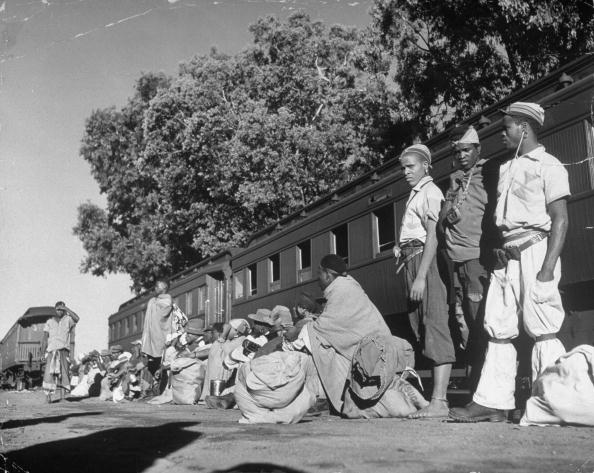 Migrant Workers Image source
Migrant Workers Image source
Impact of Mining on Women and Families
Miners were usually recruited from all over the country, thus provisions needed to be made with regards to their living conditions. They were instructed to live in compounds, which in effect became the compound/ hostel system. This compound/ hostel system, however, had adverse effect on the health and well-being of its occupants. Too many people living together in a small space with inadequate ventilation must inevitably increase the spread of disease. The living in hostels contributed to the spread of tuberculosis and HIV-related diseases. Stress and strain of a psychological nature is also involved. There is a lack of privacy and husbands are separated from their wives and children. Hostel life estranges the husband from his family. Women were left behind to care for children and perform domestic labour.
Skilled and Unskilled White Workers
White workers had more power than the black workers and could challenge the mine-owners directly, through strikes, through political parties and through newspapers. They were fighting against the mine-owners' continual attempts to replace 'expensive' white labour with 'cheap' black labour. Most of the skilled miners came from the mines of Britain - from Cornwall or Northumberland in England, and from the mines of Scotland and Wales. Many others came from the coal mines of Australia. These new immigrants brought with them not only mining skills they also brought their experience of being workers and we shall see later how important this was. They came to the Rand as full-time workers, with no land to go back to. The skilled miners of the early years had a strong influence on the working conditions of white workers in the years to come.
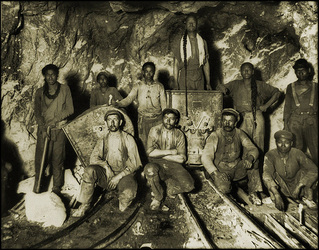 White Mine workers in a Johannesburg Mine. Image source
White Mine workers in a Johannesburg Mine. Image source
Skilled miners in South Africa got high wages. In 1897, for example, skilled miners earned 18 pounds to 22 pounds a month. That was good pay in those days, while unskilled miners were earning only two to three pounds a month.One reason for the skilled workers’ high wages was that the mines desperately needed skilled workers, as we have seen. So, from the earliest days, mine-owners offered high wages for skills, and skilled miners were in a strong position. Most of these miners saw themselves as members of the working class. They organised themselves into unions soon after they arrived. They had experience of trade unions in the countries that they came from, and they knew how to bargain for higher wages and better working conditions. The skilled miners knew how important the gold mines were to South Africa - and how important their skills were to the gold mines.
The Anglo Boer War led to the closing of the gold mines for two years. After the war there was a shortage of cheap labour. This was partly because the mine-owners tried to drop the wages of black workers. Thousands of men stayed away from the mines. Mine-owners then tried using unskilled white labour, but the skilled miners were against this plan. They were worried that these unskilled whites would not be properly trained and that they would take over the skilled jobs at lower wages. Then the mine-owners could lower the wages of all skilled miners.
Anti- Indian Legislation
Legislation was enacted in order to limit Indian trade and businesses to flourish. In 1924 the Township Franchise Ordinance was passed in Natal. This deprived Indians of municipal franchise, or voting rights along with the Rural Dealers Ordinance which aimed to cripple Indian trade. The Durban Land Alienation Ordinance was also passed in 1924 to prevent Indian ownership of land in white areas. The Transvaal Dealers (Control) Ordinance of 1925 made it a difficult task to get business licences and the Minimum wages Act led to a form of job reservation in favour of white job seekers. The Class Areas Bill was passed in 1925 was designed to segregate white and Indian people. On 23 July 1925 the Areas Reservation and Immigration and Registration (Further Provision) Bills were passed, defining Indians as aliens and recommending limiting the population by sending them back to India.
In 1926 the Mines and Works Amendments Act, or Colour Bar Act required certificates of competency for skilled work from which Indian workers were excluded. The Liquor Bill of the same year stipulated that Indians and black people could not be employed by liquor licence holders and were forbidden on licensed premises and liquor supply vehicles. The Bill became an Act on 23 June 1927 and 3000 Indians employed in the brewery trade were affected. On 2 January 1928 Section 104 of the Liquor Bill was withdrawn and Indians were again allowed to enter licensed premises. The Local Government (Provincial Powers) Act of 1926 denied Indians any citizenship rights.
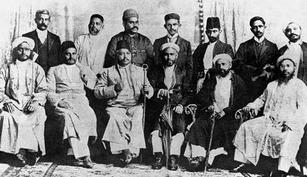 Anti-Indian Legislation Image source
Anti-Indian Legislation Image source
On 27 April 1927 the Immigration and Indian Relief (Further Provision) Bill was introduced by Minister of the Interior, Dr D. F. Malan. It required children of South African Indian parents, born outside the Union, to enter the country within three months of birth. Indian South Africans who were absent from the country for three years in a row lost their residence rights, and Indians who had entered the country illegally, mostly at the time of the Second Anglo-Boer War, were disregarded. 23 June 1927 saw Indians in the Northern Districts Act passed, which stipulated that Transvaal laws were to be applied to Indians in Utrecht, Vryheid, and Paulpietersburg. Restrictions were placed on land purchase, trade and residence rights. The Riotous Assembly Act warned of deportation of those Indians who agitated against the various restrictions. On 5 July 1927 the Nationality and Flag Act denied Indians the right to become citizens of South Africa. In 1930 the Transvaal Asiatic Land Tenure (Amendment) Bill was introduced and proposed segregation through the relocation of Indians to designated areas. The Women’s Enfranchisement Act also excluded Indian women from the vote.
In 1931 the Asiatic Immigration Amendment Act required that Indians prove they had legal status. In 1937 the Act was amended to deprive children of South African Indian parents the same rights as their parents. The Transvaal Asiatic Land Tenure (Amendment) Act of 1932, and its subsequent amendments in 1934, 1935 and 1937, established compulsory segregation of Indians and also prevented Indians from employing white workers. The 1935 Slums Act was aimed at improving conditions in locations, but actually reallocated Indian property. The Marketing and Unbeneficial Land Occupation Act of 1937 prevented Indians from representing their communities on regulatory boards and on 22 February of the same year 3 more Bills were presented that, although applicable to all “non-whites”, had a serious effect on Indians
Due to the entrance of Indians into white areas, particularly as a threat to white businesses, the Trading and Occupation of Land Restriction Act No 35 of 1943, more commonly known as the Pegging Act, was passed in May. This Act provided for official control of property transactions between whites and Indians, due to the ‘penetration’ of Indians in predominantly white areas. The Asiatic Land Tenure and Indian Representation Act of 1946, or Ghetto Act, replaced the Pegging Act and was more specific concerning property transactions between whites and Indians. Indian people could only purchase land in the Transvaal and Natal, in specially defined areas.
Forms of Labour resistance
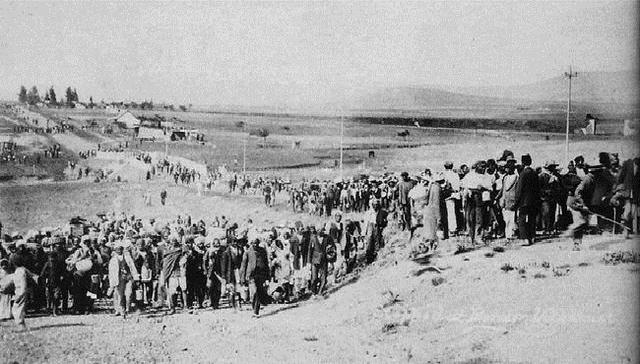 The Indian Mineworkers Strike in 1913 Image source
The Indian Mineworkers Strike in 1913 Image source
A form of resistance included to look for better jobs. After the South African War (1899-1902), thousands of African workers boycotted the gold mines because wages had dropped. They tried to find jobs on the railways and in the towns instead. As with indentured labourers, workers on the gold mines also deserted when they were unable to do anything else to improve their jobs. Where conditions in compounds were the worst, desertion was higher. Many workers also tried to limit their work by deliberately working badly, breaking their tools and not doing any more work than they had to. Often workers acted dumb by pretending that they didn't understand their orders. Although employers could have their workers tried for these 'crimes', the courts were often ineffective. As a result, there was very little employers could do to put a stop to many of these 'everyday' forms of resistance.
In 1913, African miners went on strike over wages and conditions in the compounds. White miners also went on strike over the number of hours they were expected to work on a Saturday. During 1920, Almost 70 000 African miners went on strike to demand a wage increase. Of the 35 mines, 21 were brought to a standstill during the strike. After the protest by white miners in 1913, the Chamber of Mines recognised white trade unions in 1914. Production increased between 1911 and 1920. This was a period of stability and profit for the mine owners. But by 1920 the price of gold was dropping and the mine owners were facing greater resistance from African workers.
City of Johannesburg
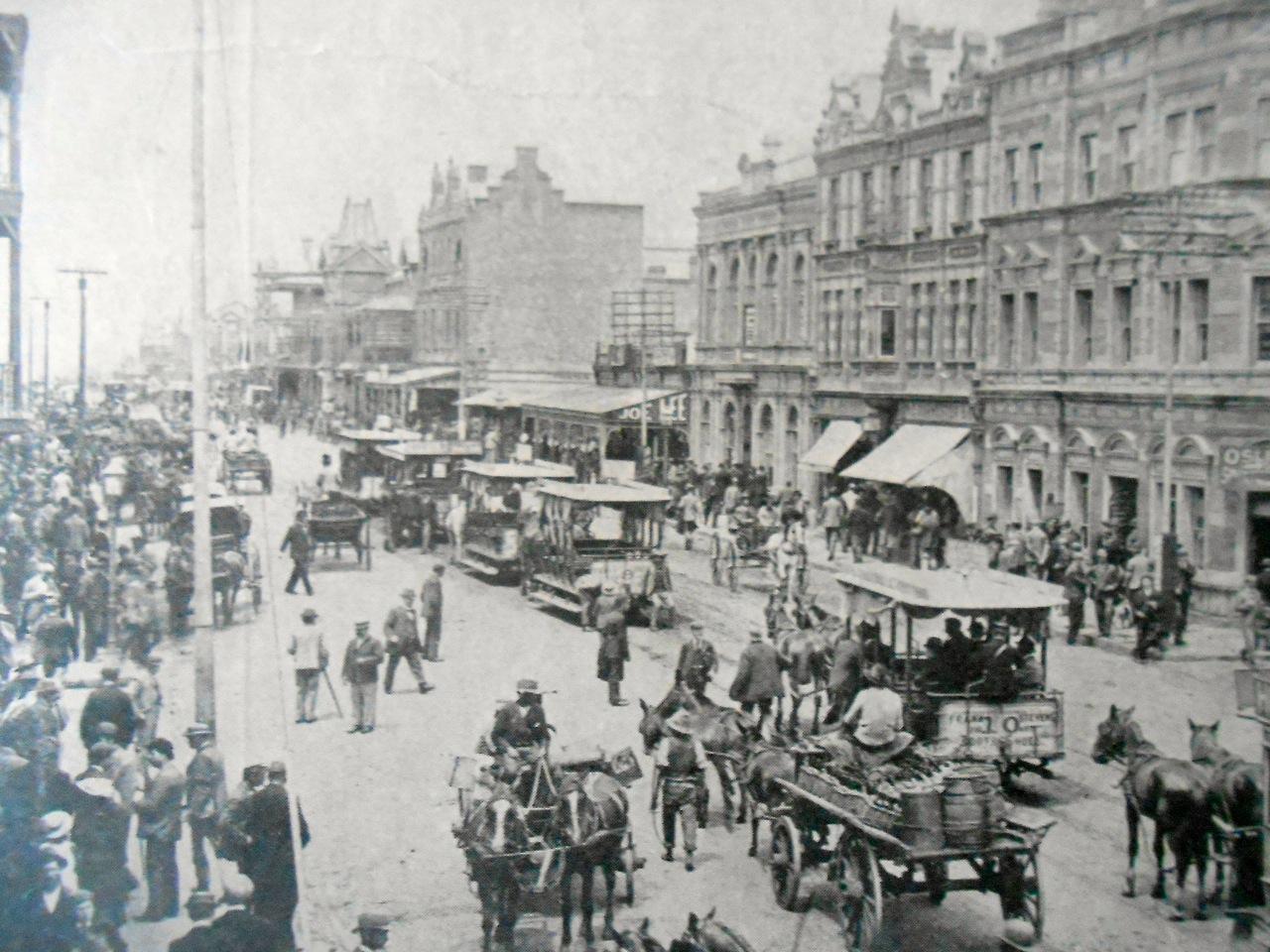 Johannesburg in the early 1890's Image source
Johannesburg in the early 1890's Image source
Gold was discovered in the City of Johannesburg in 1886 which rapidly led to urbanisation within the town and becoming one of the biggest cities in the country.Although Johannesburg only became officially a city in 1928 it was set up as a town as early as 1886. The town was set up on a piece of land that was previously a farm called Randjieslaagte. At that time the Government owned the property and auctioned off 980 stands which lead to the establishment of the town. Gold was discovered in the 1880s and triggered the gold rush. Gold was initially discovered some 400 km to the east of present-day Johannesburg, in Barberton. Gold prospectors soon discovered that there were even richer gold reefs in the Witwatersrand. Gold was discovered at Langlaagte, Johannesburg in 1886.
Johannesburg was a rough and disorganized place, populated by white miners from other continents, African tribesmen recruited to perform unskilled mine work, African women beer brewers who cooked for and sold beer to the black migrant workers, a very large number of European prostitutes, gangsters, impoverished Afrikaners, tradesmen, and Zulu "AmaWasha," Zulu men who surprisingly dominated laundry work. As the value of control of the land increased, tensions developed between the Boer government in Pretoria and the British, culminating in the Jameson Raid that ended in fiasco at Doornkop in January 1896 and the Second Boer War (1899–1902) that saw British forces under Lord Roberts occupy the city on 30 May 1900 after a series of battles to the south of its then-limits.
Major building developments took place in the 1930s, after South Africa went off the gold standard. In the late 1940s and early 1950s, Hillbrow went high-rise. In the 1950s and early 1960s, the apartheid government constructed the massive agglomeration of townships that became known as Soweto (South Western Townships). New freeways encouraged massive suburban sprawl to the north of the city. In the late 1960s and early 1970s, tower blocks (including the Carlton Centre and the Southern Life Centre) filled the skyline of the central business district. The central area of the city underwent something of a decline in the 1980s and 1990s, due to crime and when property speculators directed large amounts of capital into suburban shopping malls, decentralised office parks, and entertainment centres. Sandton City was opened in 1973, followed by Rosebank Mall in 1976, and Eastgate in 1979.
Discussion questions
1.What was the Mineral Revolution?
2.The Mineral Revolution was based on the export of what two minerals?
3.What changes were caused by the Mineral Revolution? Discuss in terms of:
a.Personal/ Social
b.Material
c.Philosophical
d.Environmental
e.Economically
4.Would the Mineral Revolution have made such a big impact such as it did in South Africa, if it occurred in any other country?
5.Who was in control of the land known as the richest known diamond-bearing territory in the world during the 'mineral revolution'?
6.How were the underground conditions for mining?
7.How is gold mined in South Africa?
8.What were the
a.‘Randlords’
b.Compounds
c.Chamber of Mines
9.What is migrant labour?
10.What were socio- economic impacts of the Mineral revolution in South Africa?
